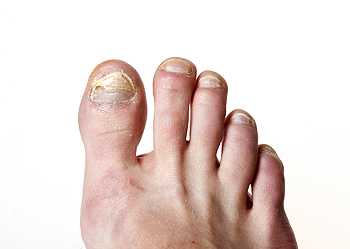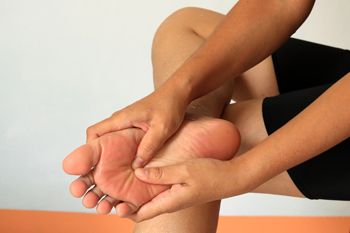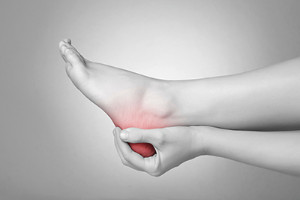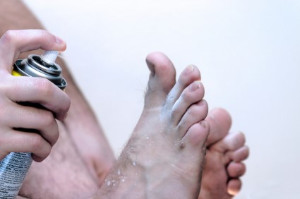 Research has indicated that fungal nail infections account for approximately half of existing nail conditions. This includes toenail fungus, which is also known as onychomycosis. The fungus that causes this type of nail infection lives and thrives in warm and moist environments. These can include public swimming pools, shower room floors, and surrounding areas. It is considered to be contagious, and can spread between people from sharing towels, shoes, or socks. It is suggested that appropriate shoes are worn while frequenting these areas, as this may minimize the risk of developing toenail fungus. If you have this type of fungus, it is suggested that you speak with a podiatrist who can properly diagnose and treat this condition.
Research has indicated that fungal nail infections account for approximately half of existing nail conditions. This includes toenail fungus, which is also known as onychomycosis. The fungus that causes this type of nail infection lives and thrives in warm and moist environments. These can include public swimming pools, shower room floors, and surrounding areas. It is considered to be contagious, and can spread between people from sharing towels, shoes, or socks. It is suggested that appropriate shoes are worn while frequenting these areas, as this may minimize the risk of developing toenail fungus. If you have this type of fungus, it is suggested that you speak with a podiatrist who can properly diagnose and treat this condition.
If left untreated, toenail fungus may spread to other toenails, skin, or even fingernails. If you suspect you have toenail fungus it is important to seek treatment right away. For more information about treatment, contact Bruce Smit, DPM of Frankfort Foot & Ankle Clinic. Our doctor can provide the care you need to keep you pain-free and on your feet.
Symptoms
Treatment
If self-care strategies and over-the-counter medications does not help your fungus, your podiatrist may give you a prescription drug instead. Even if you find relief from your toenail fungus symptoms, you may experience a repeat infection in the future.
Prevention
In order to prevent getting toenail fungus in the future, you should always make sure to wash your feet with soap and water. After washing, it is important to dry your feet thoroughly especially in between the toes. When trimming your toenails, be sure to trim straight across instead of in a rounded shape. It is crucial not to cover up discolored nails with nail polish because that will prevent your nail from being able to “breathe”.
In some cases, surgical procedure may be needed to remove the toenail fungus. Consult with your podiatrist about the best treatment options for your case of toenail fungus.
If you have any questions, please feel free to contact our office located in Frankfort, IL . We offer the newest diagnostic and treatment technologies for all your foot care needs.
Read more about Treating Toenail Fungus
 Custom orthotics are frequently prescribed to treat various foot conditions, such as plantar fasciitis, arthritis, and gait abnormalities. Once you begin wearing custom orthotics, you may find being on your feet a lot more pleasant. Unfortunately, orthotics can and do wear out over time. If you find that your feet have begun to hurt again after wearing your orthotics for a while, then it may be time to replace them. It is also recommended that you inspect your orthotics for wear and tear. If you see cracks, broken pieces, or thinned soles, the orthotics are likely past their best. It is also recommended to check the bottom of your shoes for signs of uneven wear. Orthotics are meant to correct any deformities in your feet and your shoes can tell you if there are any signs of uneven wear. If you are experiencing any type of foot pain and think that you may benefit from orthotics, or if you wear orthotics and think that you might need a new pair, it is suggested that you consult with a podiatrist.
Custom orthotics are frequently prescribed to treat various foot conditions, such as plantar fasciitis, arthritis, and gait abnormalities. Once you begin wearing custom orthotics, you may find being on your feet a lot more pleasant. Unfortunately, orthotics can and do wear out over time. If you find that your feet have begun to hurt again after wearing your orthotics for a while, then it may be time to replace them. It is also recommended that you inspect your orthotics for wear and tear. If you see cracks, broken pieces, or thinned soles, the orthotics are likely past their best. It is also recommended to check the bottom of your shoes for signs of uneven wear. Orthotics are meant to correct any deformities in your feet and your shoes can tell you if there are any signs of uneven wear. If you are experiencing any type of foot pain and think that you may benefit from orthotics, or if you wear orthotics and think that you might need a new pair, it is suggested that you consult with a podiatrist.
If you are having discomfort in your feet and would like to try orthotics, contact Bruce Smit, DPM from Frankfort Foot & Ankle Clinic. Our doctor can provide the care you need to keep you pain-free and on your feet.
What Are Orthotics?
Orthotics are inserts you can place into your shoes to help with a variety of foot problems such as flat feet or foot pain. Orthotics provide relief and comfort for minor foot and heel pain but can’t correct serious biomechanical problems in your feet.
Over-the-Counter Inserts
Orthotics come in a wide variety of over-the-counter inserts that are used to treat foot pain, heel pain, and minor problems. For example, arch supports can be inserted into your shoes to help correct overarched or flat feet, while gel insoles are often used because they provide comfort and relief from foot and heel pain by alleviating pressure.
Prescription Orthotics
If over-the-counter inserts don’t work for you or if you have a more severe foot concern, it is possible to have your podiatrist prescribe custom orthotics. These high-quality inserts are designed to treat problems such as abnormal motion, plantar fasciitis, and severe forms of heel pain. They can even be used to help patients suffering from diabetes by treating foot ulcers and painful calluses and are usually molded to your feet individually, which allows them to provide full support and comfort.
If you are experiencing minor to severe foot or heel pain, it’s recommended to speak with your podiatrist about the possibilities of using orthotics. A podiatrist can determine which type of orthotic is right for you and allow you to take the first steps towards being pain-free.
If you have any questions please contact our office located in Frankfort, IL . We offer the newest diagnostic and treatment technologies for all your foot and ankle needs.
 Hereditary sensory neuropathy is a condition characterized by nerve abnormalities in the legs and feet. An individual with this condition might feel paresthesia, a prickling or tingling sensation, in their lower limbs. Other common symptoms include feeling numbness and reduced sensitivity to pain, heat, and cold in the legs and feet. Sometimes people who are affected do not lose sensation but instead feel shooting pains in their legs and feet. People who develop this condition may be at an increased risk of foot ulcers due to the decrease in sensation in their feet. These ulcers can become infected and cause serious complications if they go unnoticed and untreated. If you have been diagnosed with peripheral neuropathy it is recommended that you are under the care of a podiatrist, who can help you in monitoring and maintaining the health of your feet and ankles.
Hereditary sensory neuropathy is a condition characterized by nerve abnormalities in the legs and feet. An individual with this condition might feel paresthesia, a prickling or tingling sensation, in their lower limbs. Other common symptoms include feeling numbness and reduced sensitivity to pain, heat, and cold in the legs and feet. Sometimes people who are affected do not lose sensation but instead feel shooting pains in their legs and feet. People who develop this condition may be at an increased risk of foot ulcers due to the decrease in sensation in their feet. These ulcers can become infected and cause serious complications if they go unnoticed and untreated. If you have been diagnosed with peripheral neuropathy it is recommended that you are under the care of a podiatrist, who can help you in monitoring and maintaining the health of your feet and ankles.
Neuropathy
Neuropathy can be a potentially serious condition, especially if it is left undiagnosed. If you have any concerns that you may be experiencing nerve loss in your feet, consult with Bruce Smit, DPM from Frankfort Foot & Ankle Clinic. Our doctor will assess your condition and provide you with quality foot and ankle treatment for neuropathy.
What Is Neuropathy?
Neuropathy is a condition that leads to damage to the nerves in the body. Peripheral neuropathy, or neuropathy that affects your peripheral nervous system, usually occurs in the feet. Neuropathy can be triggered by a number of different causes. Such causes include diabetes, infections, cancers, disorders, and toxic substances.
Symptoms of Neuropathy Include:
Those with diabetes are at serious risk due to being unable to feel an ulcer on their feet. Diabetics usually also suffer from poor blood circulation. This can lead to the wound not healing, infections occurring, and the limb may have to be amputated.
Treatment
To treat neuropathy in the foot, podiatrists will first diagnose the cause of the neuropathy. Figuring out the underlying cause of the neuropathy will allow the podiatrist to prescribe the best treatment, whether it be caused by diabetes, toxic substance exposure, infection, etc. If the nerve has not died, then it’s possible that sensation may be able to return to the foot.
Pain medication may be issued for pain. Electrical nerve stimulation can be used to stimulate nerves. If the neuropathy is caused from pressure on the nerves, then surgery may be necessary.
If you have any questions, please feel free to contact our office located in Frankfort, IL . We offer the newest diagnostic and treatment technologies for all your foot care needs.
 Sever’s disease, also known as calcaneal apophysitis, is not a disease at all, but rather an overuse injury. This condition affects the growth plate of the heel bone and is therefore most common in children and teenagers who are still rapidly growing. Sever’s disease causes inflammation in the heel, stiffness in the foot, and pain when standing, walking, running or jumping that usually improves with rest. Children who are involved in sports are the most at risk for developing Sever’s disease because they put frequent, repetitive pressure on the heel. Other risk factors for developing this condition include wearing ill-fitting shoes, having flat arches or pronated feet, and obesity. If your child is experiencing heel pain and stiffness, it is recommended that you take them to a podiatrist for treatment.
Sever’s disease, also known as calcaneal apophysitis, is not a disease at all, but rather an overuse injury. This condition affects the growth plate of the heel bone and is therefore most common in children and teenagers who are still rapidly growing. Sever’s disease causes inflammation in the heel, stiffness in the foot, and pain when standing, walking, running or jumping that usually improves with rest. Children who are involved in sports are the most at risk for developing Sever’s disease because they put frequent, repetitive pressure on the heel. Other risk factors for developing this condition include wearing ill-fitting shoes, having flat arches or pronated feet, and obesity. If your child is experiencing heel pain and stiffness, it is recommended that you take them to a podiatrist for treatment.
Sever's disease often occurs in children and teens. If your child is experiencing foot or ankle pain, see Bruce Smit, DPM from Frankfort Foot & Ankle Clinic. Our doctor can treat your child’s foot and ankle needs.
Sever’s Disease
Sever’s disease is also known as calcaneal apophysitis, which is a medical condition that causes heel pain I none or both feet. The disease is known to affect children between the ages of 8 and 14.
Sever’s disease occurs when part of the child’s heel known as the growth plate (calcaneal epiphysis) is attached to the Achilles tendon. This area can suffer injury when the muscles and tendons of the growing foot do not keep pace with bone growth. Therefore, the constant pain which one experiences at the back of the heel will make the child unable to put any weight on the heel. The child is then forced to walk on their toes.
Symptoms
Acute pain – Pain associated with Sever’s disease is usually felt in the heel when the child engages in physical activity such as walking, jumping and or running.
Highly active – Children who are very active are among the most susceptible in experiencing Sever’s disease, because of the stress and tension placed on their feet.
If you have any questions, please feel free to contact our office located in Frankfort, IL . We offer the newest diagnostic and treatment technologies for all your foot and ankle injuries.
The pain that is experienced with a broken toe can be debilitating. It may be difficult to walk, and any pressure that is exerted on the toe can cause severe pain and discomfort. A common cause of a broken toe is stubbing it against a piece of furniture. Additionally, if a heavy object is dropped on it, the result may be a fractured toe. Symptoms can include bruising of the toe and surrounding areas, and in severe cases, the toe may look deformed. In many cases effective treatment can consist of using a method that is referred to as buddy taping. This consists of taping the affected toe to the toe next to it, and this is often helpful in providing the stability that is necessary as the healing process occurs. If you feel you may have a broken toe, it is suggested that you confer with a podiatrist who can offer you correct treatment options.
Ingrown toenails may initially present themselves as a minor discomfort, but they may progress into an infection in the skin without proper treatment. For more information about ingrown toenails, contact Bruce Smit, DPM of Frankfort Foot & Ankle Clinic. Our doctor can provide the care you need to keep you pain-free and on your feet.
Ingrown Toenails
Ingrown toenails are caused when the corner or side of a toenail grows into the soft flesh surrounding it. They often result in redness, swelling, pain, and in some cases, infection. This condition typically affects the big toe and may recur if it is not treated properly.
Causes
You are more likely to develop an ingrown toenail if you are obese, have diabetes, arthritis, or have any fungal infection in your nails. Additionally, people who have foot or toe deformities are at a higher risk of developing an ingrown toenail.
Symptoms
Some symptoms of ingrown toenails are redness, swelling, and pain. In rare cases, there may be a yellowish drainage coming from the nail.
Treatment
Ignoring an ingrown toenail can have serious complications. Infections of the nail border can progress to a deeper soft-tissue infection, which can then turn into a bone infection. You should always speak with your podiatrist if you suspect you have an ingrown toenail, especially if you have diabetes or poor circulation.
If you have any questions, please feel free to contact our office located in Frankfort, IL . We offer the newest diagnostic and treatment technologies for all your foot care needs.
 The foot condition that is known as athlete’s foot is caused by a fungus. This type of fungus is referred to as tinea pedis, and lives and thrives in warm and moist environments. These can include public shower room floors, locker rooms, pools, and their surrounding areas. Some of the symptoms that patients experience may include red and itchy skin, especially between the toes and the bottom of the feet, and small blisters, which may develop in severe cases. There are methods that can be implemented which can help to control the spread of athlete's foot. These can consist of wearing appropriate shoes while frequenting these types of areas, and avoiding sharing towels, shoes, and socks. Mild relief may be found when an antifungal powder or spray is used. If you are afflicted with this type of fungus, it is suggested that you speak to a podiatrist who can prescribe medicine that can promote recovery.
The foot condition that is known as athlete’s foot is caused by a fungus. This type of fungus is referred to as tinea pedis, and lives and thrives in warm and moist environments. These can include public shower room floors, locker rooms, pools, and their surrounding areas. Some of the symptoms that patients experience may include red and itchy skin, especially between the toes and the bottom of the feet, and small blisters, which may develop in severe cases. There are methods that can be implemented which can help to control the spread of athlete's foot. These can consist of wearing appropriate shoes while frequenting these types of areas, and avoiding sharing towels, shoes, and socks. Mild relief may be found when an antifungal powder or spray is used. If you are afflicted with this type of fungus, it is suggested that you speak to a podiatrist who can prescribe medicine that can promote recovery.
Athlete’s Foot
Athlete’s foot is often an uncomfortable condition to experience. Thankfully, podiatrists specialize in treating athlete’s foot and offer the best treatment options. If you have any questions about athlete’s foot, consult with Bruce Smit, DPM from Frankfort Foot & Ankle Clinic. Our doctor will assess your condition and provide you with quality treatment.
What Is Athlete’s Foot?
Tinea pedis, more commonly known as athlete’s foot, is a non-serious and common fungal infection of the foot. Athlete’s foot is contagious and can be contracted by touching someone who has it or infected surfaces. The most common places contaminated by it are public showers, locker rooms, and swimming pools. Once contracted, it grows on feet that are left inside moist, dark, and warm shoes and socks.
Prevention
The most effective ways to prevent athlete’s foot include:
Symptoms
Athlete’s foot initially occurs as a rash between the toes. However, if left undiagnosed, it can spread to the sides and bottom of the feet, toenails, and if touched by hand, the hands themselves. Symptoms include:
Diagnosis and Treatment
Diagnosis is quick and easy. Skin samples will be taken and either viewed under a microscope or sent to a lab for testing. Sometimes, a podiatrist can diagnose it based on simply looking at it. Once confirmed, treatment options include oral and topical antifungal medications.
If you have any questions, please feel free to contact our office located in Frankfort, IL . We offer the newest diagnostic and treatment technologies for all your foot care needs.
 Each foot consists of twenty six bones, numerous ligaments, muscles, and tendons. Everyday wear and tear or an injury can compromise general foot function, and uncomfortable foot conditions may occur. A bunion is a bony formation that develops on the side of the big toe, and can happen from wearing shoes that do not fit correctly. Blisters can occur on the back of the heel or on the bottom of the feet, and this is generally a result of increased friction. A corn is a hardened area that can gradually develop on top of the toes or between them, and can cause severe pain and discomfort. If you have these or other conditions that can lead to chronic foot pain, it is strongly advised that you are under the care of a podiatrist who can guide you toward proper treatment techniques.
Each foot consists of twenty six bones, numerous ligaments, muscles, and tendons. Everyday wear and tear or an injury can compromise general foot function, and uncomfortable foot conditions may occur. A bunion is a bony formation that develops on the side of the big toe, and can happen from wearing shoes that do not fit correctly. Blisters can occur on the back of the heel or on the bottom of the feet, and this is generally a result of increased friction. A corn is a hardened area that can gradually develop on top of the toes or between them, and can cause severe pain and discomfort. If you have these or other conditions that can lead to chronic foot pain, it is strongly advised that you are under the care of a podiatrist who can guide you toward proper treatment techniques.
Foot Pain
Foot pain can be extremely painful and debilitating. If you have a foot pain, consult with Bruce Smit, DPM from Frankfort Foot & Ankle Clinic. Our doctor will assess your condition and provide you with quality foot and ankle treatment.
Causes
Foot pain is a very broad condition that could be caused by one or more ailments. The most common include:
Diagnosis
To figure out the cause of foot pain, podiatrists utilize several different methods. This can range from simple visual inspections and sensation tests to X-rays and MRI scans. Prior medical history, family medical history, and any recent physical traumatic events will all be taken into consideration for a proper diagnosis.
Treatment
Treatment depends upon the cause of the foot pain. Whether it is resting, staying off the foot, or having surgery; podiatrists have a number of treatment options available for foot pain.
If you have any questions, please feel free to contact our office located in Frankfort, IL . We offer the newest diagnostic and treatment technologies for all your foot care needs.
 While flip-flops are commonly worn in the summer, over-wearing them can cause potential problems for the feet. Due to the lack of support flip-flops provide, the toes often over-grip the shoe, which can lead to multiple foot conditions. This over-gripping can cause tendonitis to occur and can potentially make existing bunions or hammertoes worse. The strain of the grip can also lead to irritating the plantar fascia and may cause the ailment known as plantar fasciitis. The lack of support from flip-flops can also lead to a higher potential of an ankle sprain. Since there are so many risks involved, it is important to find a flip-flop that is supportive by having thicker straps and soles, as well as an arch support. If you are experiencing any type of foot pain due to your flip-flops, it is important that you consult with a podiatrist for proper care and different ways to implement preventative measures.
While flip-flops are commonly worn in the summer, over-wearing them can cause potential problems for the feet. Due to the lack of support flip-flops provide, the toes often over-grip the shoe, which can lead to multiple foot conditions. This over-gripping can cause tendonitis to occur and can potentially make existing bunions or hammertoes worse. The strain of the grip can also lead to irritating the plantar fascia and may cause the ailment known as plantar fasciitis. The lack of support from flip-flops can also lead to a higher potential of an ankle sprain. Since there are so many risks involved, it is important to find a flip-flop that is supportive by having thicker straps and soles, as well as an arch support. If you are experiencing any type of foot pain due to your flip-flops, it is important that you consult with a podiatrist for proper care and different ways to implement preventative measures.
Flip-flops are not always the best choice of footwear. If you have any concerns about your feet or ankles, contact Bruce Smit, DPM from Frankfort Foot & Ankle Clinic. Our doctor will assist you with all of your foot and ankle needs.
Flip-Flops and Feet
When the weather starts warming up, people enjoy wearing flip-flops. Flip-flops are comfortable, stylish, and easy to slip on and off; they're perfect for any summer beach goer. However, these shoes can cause harm to the feet.
How Can Flip-Flops Affect Me Long-Term?
Are There Injuries Associated with Flip-Flops?
Yes. Since flip-flops are relatively weak and do not provide the same amount of support as sneakers, people who wear flip-flops regularly are more susceptible to injuries. On top of that, the open nature of the shoe makes your feet more prone to other problems, such as cuts and even infections. Common injuries and ailments include:
I like Wearing Flip-Flops. Are There Safe Alternatives?
When buying flip-flops, try to find ones that have sturdy soles and that are made of high-quality materials that will support for your feet. These flip-flops will cost more but will also last longer as a result.
If you have any questions please feel free to contact our office located in Frankfort, IL . We offer the newest diagnostic and treatment technologies for all your foot and ankle needs.